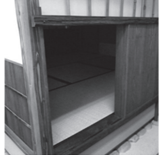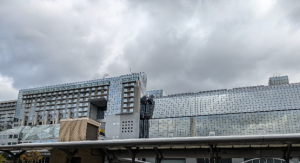Nijiriguchi and the Submarine~Tragedy of Kyoto~
Yoshie Doi
 Nijiriguchi |
 Kyoto Station Building Photographed on August 16, 2024 |
When entering a boat at the dock, one passes through a narrow entrance called a nijiriguchi, and Rikyu was inspired by this ordinary scene to design the nijiriguchi for the teahouse. When entering the teahouse through the nijiriguchi, even samurai had to put down their swords and enter the teahouse. In an era when there was a class system, this idea is in keeping with the universal spirit of tea, which is said to be “heartfulness from a single bowl.
The reason why Japanese culture is said to be universal is probably because it is backed by human power. The sensibility that can elevate ordinary everyday scenery to the level of art is wonderful. Kyoto people, in particular, are surrounded by mountains and see them every day, 365 days a year.
Yasunari Kawabata, who won the Nobel Prize in Literature for “The Old Capital,” wrote the following in his press conference upon receiving the Order of Culture during a serialization in the Asahi Shimbun newspaper, in his section “Why did I set my story in Kyoto?”
”I want to write about the things that are gradually disappearing, even in old capitals. I often come to Kyoto, but I only explore the famous places and historical sites from the outside. It’s as if I know nothing about life inside.”
The Swedish Academy’s Nobel Prize evaluation (released in January 2017) states that “Kyoto beautifully expresses the Japanese way of life, vividly depicts the ethics, aesthetic sense, and people, and is free of Western influences.” (It was not open to the public for 50 years, but was shown for the first time in January 2017.) It is important to understand the Japanese way of life and utilize it in urban development.
I receive the latest research results and information from overseas every day, and Professor Toshio Nishi of Stanford University, who has visited cities around the world, wrote about the Kyoto Station building in a blog titled “The Tragedy of Kyoto.” He said that when he saw the new Kyoto Station building, he was very shocked and asked, “Is this a naval base?” This is because the color of Kyoto Station is battle gray, the color of a submarine.
It has a wartime grey colour scheme that is hard to notice. Apparently, naval ships are all painted grey as a camouflage so they cannot be seen. Apparently, the station felt like an upside-down warship. When he first saw it, he thought, “Is this sane? Who would do something like this…?”
I remember ordering and looking at all the design drawings from the station building competition at the time. I remember a friend of mine who was studying architecture at Kyoto University’s graduate school repeatedly bragging about how advanced architectural techniques were used and how amazing the technology was.
I had heard that there was a height restriction and that the lowest design was adopted.I don’t know if they were inspired by submarines, or not s, but I was shocked at the similarity.
It may be a tragedy for Kyoto people who are unaware of the resemblance of the shape to a wartime submarine. A friend of mine who was the general manager of a hotel told me many times that overseas guests were shown around Kyoto by car from Kansai Airport, without being shown Kyoto Station.
This incident made me realize how important it is to know common sense around the world.
The end of document
Translated by Masami Otani
